TechRadar Verdict
Bluehost’s low starter prices, responsive support and feature-packed shared, WordPress and ecommerce hosting plans make it an appealing choice for many personal and small business users. Just make sure to enquire about renewal prices.
Pros
- +
Easy to use account panel and hosting management tools
- +
Responsive live chat and telephone support
- +
Low introductory prices
- +
Above average speeds in testing
- +
Lots of business-friendly extras with many plans
Cons
- -
VPS, dedicated ranges are small and have few configuration options
- -
No ticket support
- -
No choice of datacenter
- -
No uptime guarantee
- -
Above average prices after renewal
- -
Renewal prices are hidden
Why you can trust TechRadar
Bluehost, one of the world's largest and best web hosting providers, has almost two decades of experience in helping users build and host quality websites.
Bluehost is owned by Newfold Digital (previously Endurance International Group), the company behind other major hosting names like HostGator, iPage, Domain.com and Web.com, and SEO tool Yoast too.
Bluehost has a real depth of knowledge in WordPress which goes way beyond most competitors. It has developers working on the platform full-time, and has been directly recommended by WordPress.org since 2005.
Datanyze' Web Hosting Share report places the company in 6th place amongst business users. Only hosting giants such as GoDaddy, Amazon and Google scored higher.
Cheapest Bluehost Shared Plan | $7.99 $1.99 p/m | 75% off
A fantastic bargain for TechRadar visitors, Bluehost has cut the price of its Shared Plan (regularly $7.99 p/m) down to a mere $1.99 per month for the first term only. You get $175 in offers 24/7 support plus free domain and site builder and 30-day money-back guarantee.
What types of hosting does Bluehost offer?
Bluehost offers low-cost shared hosting, ideal for personal or small business sites that don't need to handle much traffic (less than 20K visitors a month).
A wide range of the best WordPress hosting plans could work for anything from a simple personal blog, to a feature-packed business-critical site, or a leading-edge web store. Where Bluehost stand out is with their WordPress plans. They've heavily invested in WordPress and their WordPress academy is great for WordPress beginners.
Bluehost's dedicated and VPS hosting gives you a far more powerful hosting environment, delivering the maximum possible speed for the most demanding projects.
The company also offers a very full range of add-on products and services: website design, domain registration, email hosting, premium support and more.
Next, we'll break down these various ranges, look at what they offer, and explore which hosting plans are best for different types of sites.

Bluehost shared hosting
Opt for a shared hosting plan and your website is stored on a server which also hosts many other accounts. This type of hosting saves money, because the cost of the server is shared between many users. But it runs the risk of unstable performance, because the server's resources - the processor, the RAM, the network connection - are also shared by all the accounts.
Bluehost's shared range is priced from $2.95 a month on the annual plan ($11.99 on renewal). This supports 10 websites and a lower than average 10GB storage, but the feature list scores free domain, free SSL, free CDN (Content Delivery Network), automated WordPress installation, a bundled website builder, and 24/7 support via live chat and telephone. Upgrading to the other shared plans adds resources to improve speeds, and throws in some valuable extras. The top Pro plan ($13.95 a month billed annually, $28.99 on renewal) includes 100GB NVMe storage, for example.
These are capable products, easy to manage, faster than most (more on that later) and powerful enough to handle many personal and small business sites.
But the plans are also more expensive than some, once the introductory deals end. The cheapest plans don't offer backups, and there are potential extra costs elsewhere. A free domain sounds great, for instance, but Bluehost’s above-average annual renewal fees ($21.99 for .com vs. $9.98 at Namecheap, for instance) mean you may pay more over time.
If it's important to make savings, consider Hostinger. The company's Premium shared hosting plan is priced similarly to Bluehost's cheapest plans, at $2.99 a month on the annual plan, $11.99 on renewal. It can't quite match Bluehost for management tools (no cPanel, no Softaculous), although its own control panels are still better than most. But it scores in other areas, with weekly backups, 100GB storage and support for 100 websites, and our performance tests found Hostinger and Bluehost deliver very similar speeds.
Watch out for hidden prices
Bluehost is quick to tell you that you get a free domain with your hosting and if you want to purchase one separately it'll only cost you $12.99 for the first year. It's not so forthcoming on what it will cost you in the years after. They do tell you but it's on a different page and it feels a little too easy for beginners to get caught up here and get a surprising bill in their second year. Even as an experienced web hosting user I found it difficult to uncover the renewal price and had to ask support whom were more than happy to share the information with me.
It's not really the experience I want to receive or an experience that I think is fair on beginners. Especially as the renewal price is quite a bit more expensive than competitors ($14.98 vs $21.99 +$15 for privacy protection). If it was me buying Bluehost's hosting, I would decline the free domain and set it up with Namecheap or a different domain registrar to save myself the hassle of changing the management of the domain in 12 months.

Bluehost WordPress hosting
WordPress is the world's leading website creation platform. It's not difficult for home users to learn, yet is also powerful enough to build and run powerful business sites, huge web stores, and more.
Bluehost's $2.75 a month shared hosting plan can automatically install WordPress, and is fine if you just want to find out how the platform works. But it doesn't have many specialist WordPress features, and you can get similar plans from other hosts for less.
Bluehost's WP Pro range (from $19.95 a month over three years) extends your WordPress possibilities with premium themes to give your site a facelift, a staging environment for safer testing of website changes, and automatic WordPress updates.
Additional hosting features include unlimited storage, support for unlimited sites, malware detection and daily scheduled backups.
Business-friendly extras include marketing tools, site traffic analytics and SEO guidance, while the best plans include PayPal integration and a high-speed search tool.
This is a nicely-judged mix of features, with plenty of appeal for the target small business audience. But if you're looking to save money, and don't need Bluehost's business tools, HostGator's managed WordPress tools include free migration, domain, backups and malware scanning, and are priced from $3.75 a month on the three-year plan ($10.99 on renewal.)

Bluehost VPS hosting
VPS (Virtual Private Server) hosting is a scheme where a physical server is divided up into individual server environments. There are far fewer accounts on a server than you'll see with shared hosting, and your VPS doesn't have to share its resources with other sites. That's a real performance plus, and while some shared hosting plans might struggle with 10,000 visitors a month, a good VPS can usually handle hundreds of thousands.
Bluehost has three VPS plans. The simplest gives you 2 CPU cores, 4 GB DDR5 RAM, 100 GB NVMe storage, unmetered bandwidth and a cPanel/WHM license for $ a m46.99/ month over three years, $65.99 on renewal. At the top of the range, an 8 core, 16 GB DDR5 RAM, 450 GB NVMe storage and unmetered bandwidth setup is priced at $94.99 a month over three years, $140.99 on renewal.
There's nothing wrong with these systems, and we found that they deliver decent performance for most small and mid-range sites. But three plans doesn’t give you a lot of choice.
On CPU cores, for instance (a measure of processor power), some providers have VPS plans ranging from one to 24 or even 32 cores. Bluehost’s four to eight core plans will work for some, but there’s no way it can begin to satisfy everyone (and there are no way to reconfigure the plans to suit more demanding users, either.)
IONOS' VPS plans are mostly for experienced users who know what they're doing, but they’re built to address a far wider audience than Bluehost.
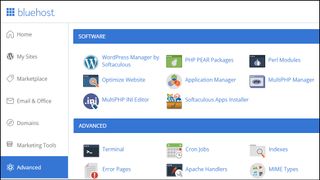
Bluehost dedicated hosting
Selecting a dedicated hosting package gets you the maximum resources and control: an entire web server, for your use only. No more sharing, no more unexpected slowdowns because another user's site is busy, just consistent high speeds, day and night.
Bluehost has a tiny range of only three dedicated hosting plans. They're very similar, too.
The Starter plan features 8 CPU cores, 32 GB DDR5 RAM, 1000 GB NVMe storage and unmetered bandwidth for $141.19 a month over three years ($188.79 on renewal).
The high-end Premium plan has 32 CPU cores, 128 GB DDR5 RAM, 3000 GB NVMe storage for $312.19 a month over three years ($391.19 on renewal.)
These plans are fairly priced, and should provide decent performance for your latest high-powered, speed-critical web projects. But as with the VPS range, they only cover a very small part of the market, and there many other needs Bluehost doesn't address.
Alternatively, consider InMotion Hosting. It's a little more expensive than Bluehost, but has more plans, managed and unmanaged options, flexible billing (1, 3, 6, 12 months) and more, just some of the reasons it's top of the list in our Best Dedicated Hosting guide.

Does Bluehost have a website builder?
Bluehost offers a low cost WordPress website builder, with plans covering everything from small personal blogs to medium-sized business sites and even some capable web stores.
The reasonably-priced starter plan includes 300+ templates, prebuilt designs for various industries and site types, and a drag-and-drop editor to easily add pictures, text, videos, forms and other blocks to your page.
Bluehost's website builder is probably overkill if you're just looking for an easy way to create a simple family site. But if you're building something for a business, or you'd like more configuration and editing options, it's an appealing choice.

Can you build a web store with Bluehost?
The Bluehost website builder offers a simple and low-cost route to building a web store, as we've discussed above.
The company also has a couple of WooCommerce hosting plans with even more features. (WooCommerce is a powerful WordPress plugin which gives access to every ecommerce feature you're ever likely to need.)
The Standard plan starts at $7.45 a month and renews at $18.99. Bluehost doesn't explain how many products you can reasonably list with this plan but rather how many websites you can host (50) which doesn't really help. What does help is the additional extras you get for free for your business. Such as, store analytics, shipping labels, Yoast SEO, and secure online payments.
If you're a Bluehost fan (or a current customer), its WooCommerce plans provide a capable way to build a quality web store. But otherwise, there's not much here to justify choosing these plans ahead of other provider's WooCommerce hosting.
Consider InMotion Hosting for a wider range of WooCommerce plans, with more features and performance-boosting tweaks. A2 Hosting goes further, with optimized Magento and OpenCart software.
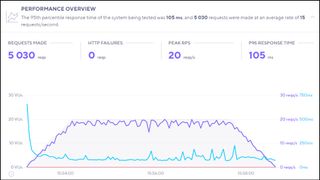
How fast is Bluehost?
Performance matters in web hosting, even for the cheapest of plans. A slow site, regularly down, could be worse than having no website at all.
We measure uptime by first creating a test WordPress site on a shared hosting plan, then using the monitoring service Uptime.com to access it every five minutes for 14 days and log what happens.
Bluehost managed a perfect 100% uptime. We expect that for a short test, but it doesn't always happen: four of our last 15 providers had some downtime during the monitoring period.
We check website performance by using GTmetrix to load a test WordPress page, then measure how long it takes to load the main content of a page (a figure known as Largest Contentful Paint, or LCP). A low LCP is good news, as it means your website appears snappier and more responsive to visitors.
Bluehost's LCP was only 0.603 seconds, earning it second place in our last 15 tests, and noticeably ahead of budget providers including Domain.com (1.5 seconds) and iPage (1.6 seconds).
Occasional download speed tests are important, but they don't tell you how a server performs when it has several visitors accessing your site at the same time. To measure performance under load, we use k6 to unleash 20 users on our site simultaneously, and watch how it copes. Bluehost's were mid-range but acceptable, with our site handling an average 15 requests per seconds.
These results are positive, and put Bluehost towards the top of our shared hosting performance rankings. But keep in mind that we only ran tests on a single shared hosting plan; if you're looking at a VPS plan, dedicated hosting or anything else, you may see very different results.
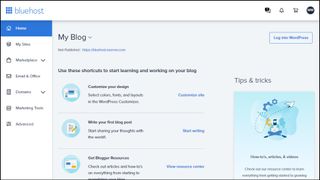
How easy is Bluehost to use?
Bluehost's account control panel is a good-looking web home which makes it simpler than most to get started on your site.
WordPress comes preinstalled, for instance, no need to do it yourself. Handy shortcuts to 'Customize your design' or 'Write your first blog post' allow you to immediately begin work on your site, even if you've never used WordPress before. Alternatively, if you're more experienced, you can access the regular WordPress dashboard with a click.
Clicking 'Advanced' on the Bluehost sidebar gives you access to cPanel. Whether you're looking to create email accounts, upload or manage files, work with databases or find out how your site traffic has been this month, there are tools to help here.
Although Bluehost installs WordPress by default, it's not your only option. CPanel also includes Softaculous, a top-notch automated installer which can set up forums, ecommerce website builders, social networking platforms, wikis and hundreds of other apps, usually with just a click or two.
Web hosting can be a complicated business, and even experts might struggle at times. But Bluehost's well-designed website and industry-standard tools score higher than most for both helping users find the features they need, and then providing all the functionality necessary to get the job done.

What is Bluehost's support like?
Bluehost offers 24/7 support via its website, live chat and telephone. There's no ticket or email option, potentially a problem with ongoing issues as you may have to explain your problem all over again with every support session. (In one case, with a non-critical issue which was annoying but didn't affect our website, we've spent around six hours across seven support sessions, and it's still not been fixed.)
Bluehost's web knowledgebase has a huge range of detailed and helpful articles, neatly organized into sensibly-named categories: WordPress, Domains, Email, Control Panel and more.
The site doesn't always present these in the best order. Choose the WordPress category, for instance, and the first hit is the release notes for WordPress 5.0, which first appeared in 2018. That's not going to help anyone at all.
You can use keywords to search the database, though, which delivers marginally better results. But you'll find what you need, even if it does take a touch more scrolling and clicking than we'd like. And once you do, we found most articles do a great job of explaining their issues and pointing us to the best solutions.
Bluehost's live chat support seems well staffed; we've never waited more than a couple of minutes for an agent to appear, and usually it's much less.
The agents are friendly and helpful, and happy to stick with you for as long as it takes (we've had sessions of an hour or more.) They generally give very good advice for common issues, but that's not always the case with unusual problems.
For example, when presenting agents with the issue ‘your dashboard has been displaying the same Setting Up Backups message for three weeks’, the agents focused entirely on workarounds for the issue (access backups from this menu instead) rather than addressing the root concern (an area of the dashboard isn’t working or useable.)
The lack of a ticket system can be a problem. On a couple of occasions, we had agents tell us they'd escalate the Setting Up Backups issue to admins to get it fixed. The issue wasn't fixed, but because there was no ticket, we had no quick way to follow up on the escalation promise and check what was going on.
Bluehost's telephone support is also easy to use, and again, it connected us to an agent within a couple of minutes. He displayed more knowledge than the live chat team, did a better job of handling the Setting Up Backups question, and explaining to us how to perform a complex troubleshooting task.
Overall, Bluehost offers decent all-round support in most situations. We'd really, really, really like ticket support, but the current setup should help you solve most common problems without difficulty, and that's far better than we see with most of the competition.
Final verdict
The company’s tiny and not-very-configurable VPS and Dedicated plans mean Bluehost is less likely to work for the most demanding business users, but overall, Bluehost remains a quality provider who delivers faster, more reliable and better quality hosting than most of the competition.
Bluehost’s underpowered VPS and dedicated hosting plans mean it may not work for the largest and most demanding business-critical sites, but it excels everywhere else, with all the feature-packed shared, WordPress, website-building and ecommerce plans you need to build fast and reliable personal and small to medium business sites.
Bluehost FAQs
What payment types does Bluehost support?
Bluehost accepts payment via card only.
Does Bluehost offer refunds?
Buy a Bluehost hosting plan, or some add-on products and you're protected by a 30-day money-back guarantee. That's typical for the hosting world, although a few providers offer more: InMotion Hosting gives you 90 days, HostGator 45 days.
We noticed one or two minor issues. Bluehost doesn't offer refunds on SSL certificates, for instance; Hostinger does. But generally, this is a straightforward, catch-free guarantee which gives you exactly the protection you'd expect.

Does Bluehost have an uptime guarantee?
Bluehost doesn't quote any target uptime figure, or have any formal method of compensating you if your server is down for a lengthy period.
That's a little disappointing. Most providers quote uptime figures of at least 99.9%, some 99.99%, and say they'll give you credits if the service doesn't hit the mark.
These 'guarantees' don't always mean very much, though. The small print might say downtime doesn't count if it's due to 'unforeseeable circumstances', for instance, something which could be used to rule out almost anything.
Overall, we'd prefer a host to have an uptime guarantee, but if this doesn't happen, it's not a disaster. We'll look at our own and other measurements of uptime, instead, and in our experience Bluehost scores very well.
Where are Bluehost's data centers?
Bluehost has local data centers for its various regions - USA, India, China - but your site is automatically assigned to the nearest location when you sign up. Buy at bluehost.com and your website is hosted in Bluehost's USA data center, for instance; use bluehost.in and it's hosted in India.
For comparison, GoDaddy has data centers in North America, India, Singapore and Europe, and you're able to choose which data center to use for each hosting plan. That can be an advantage, as it gives you a better chance of hosting your website close to its main audience, improving download speeds.
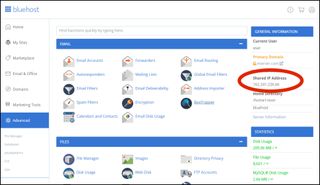
What is my Bluehost IP address?
Finding your website server's IP address can be handy, especially if you need to point a domain hosted elsewhere to your website.
There's no single way to manage this on Bluehost - it depends on your product and control panel - but if your plan has access to cPanel, it only takes a moment.
Log into your Bluehost account dashboard (my.bluehost.com).
Click Advanced in the left-hand sidebar.
Browse the General Information box on the right. The server IP address is displayed as 'Shared IP address.' (If you don't see a General Information box, look for and click a Server Information link).

What are Bluehost's nameservers?
Bluehost's nameservers are:
ns1.bluehost.com 162.88.60.37
ns2.bluehost.com 162.88.61.37
If you need more help, the support site has several useful articles on nameservers and DNS

How do I cancel a Bluehost product?
Log into your Bluehost control panel (my.bluehost.com).
Click the account icon top right (it'll have your initials in a circle) and select My Products.
Find the plan you'd like to cancel, click the More icon to its right (three dots in a vertical line) and select Renewal Options.
Choose Manual Renew and you won't be charged again. Your subscription will expire at the end of its term.
If you think there's a chance you might want to cancel a plan, make the decision as early as you can. Bluehost's auto-renewal scheme takes your money 15 days before the plan expires, so if you leave this to the last minute, there's a good chance you'll be too late.
Check out the latest Bluehost promo codes.

James is a tech journalist covering interconnectivity and digital infrastructure as the web hosting editor at TechRadar Pro. James stays up to date with the latest web and internet trends by attending data center summits, WordPress conferences, and mingling with software and web developers. At TechRadar Pro, James is responsible for ensuring web hosting pages are as relevant and as helpful to readers as possible and is also looking for the best deals and coupon codes for web hosting.




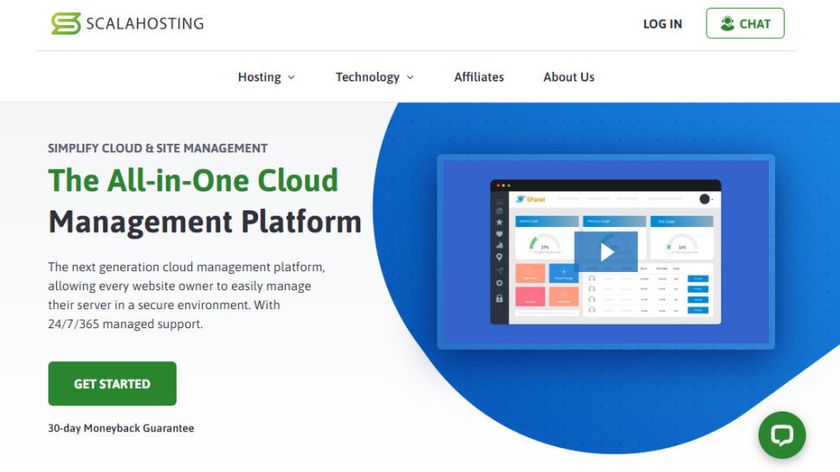








The M3 MacBook Air is officially discontinued, but the M2 MacBook Air will live on elsewhere and that's good news

Jonas vs Price live stream: how to watch today's boxing online from anywhere, start time, full undercard

ChatGPT 4.5 understands subtext, but it doesn't feel like an enormous leap from ChatGPT-4o













